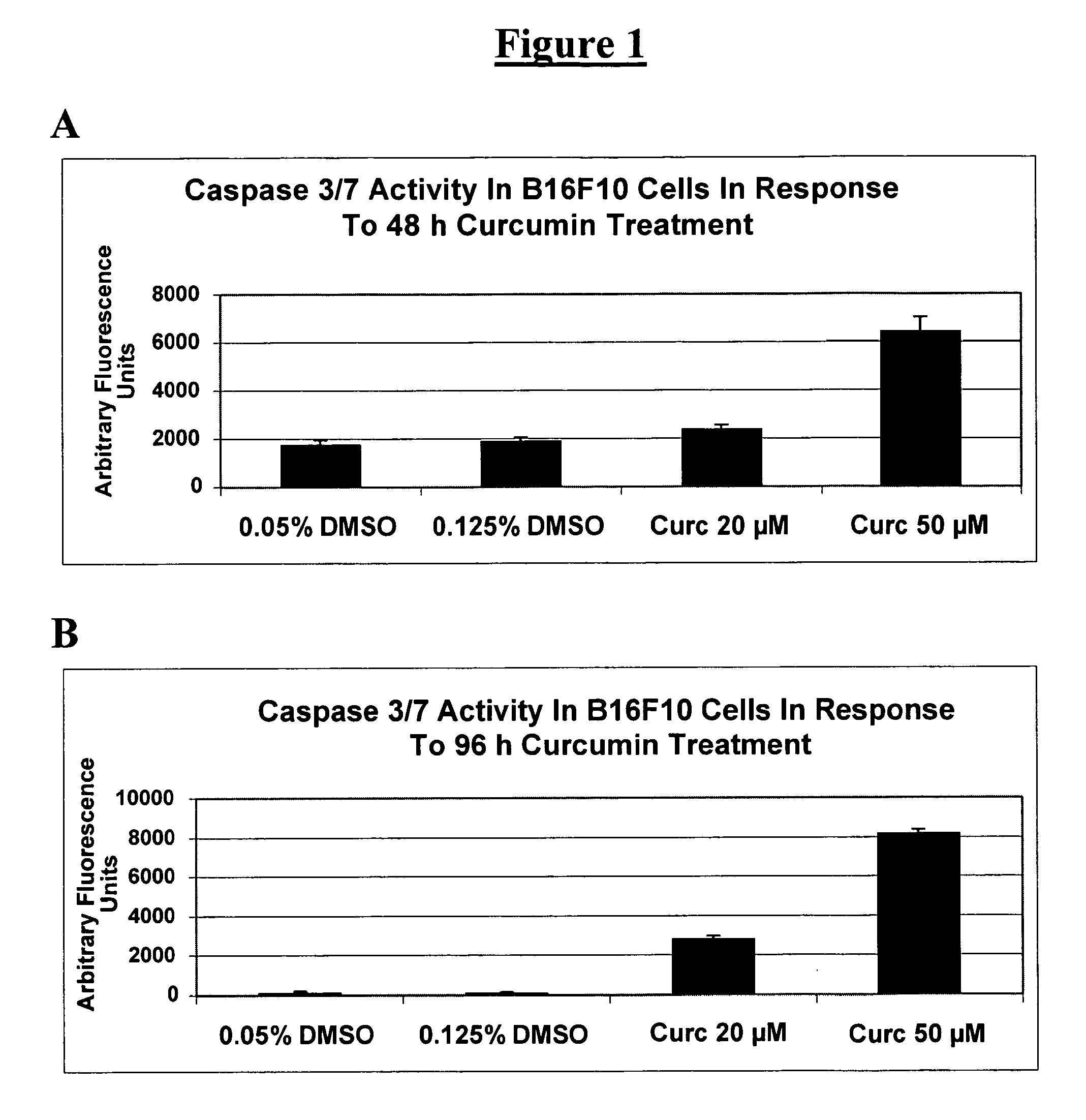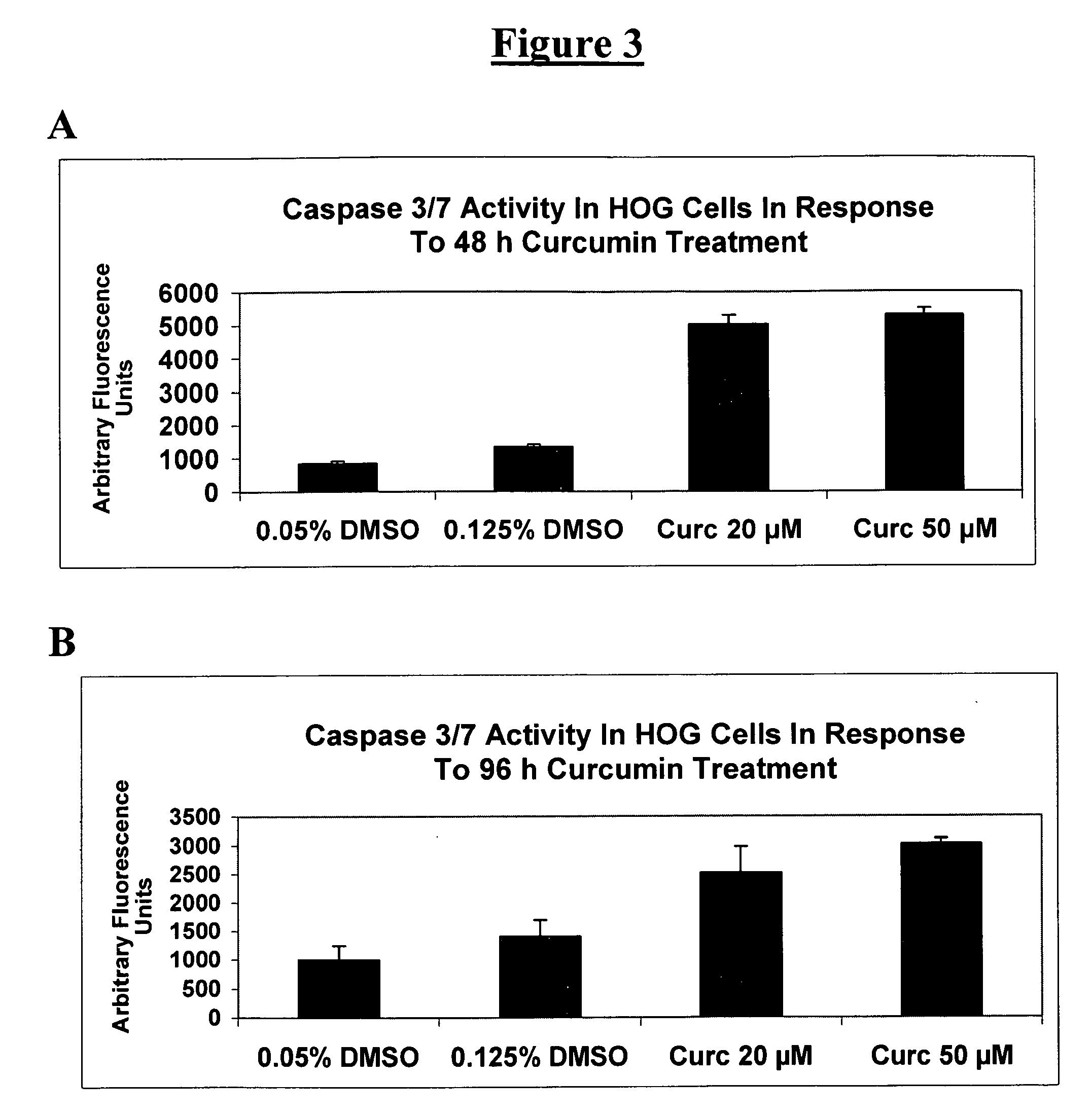Use of curcumin to block brain tumor formation in mice
a brain tumor and curcumin technology, applied in the field of mice brain tumor blocker, can solve the problems of limited pediatric use of conventional therapies like radiation, no studies report the use of curcumin in blocking brain tumor formation in vivo, and no studies report the use of curcumin in eliminating cancer
- Summary
- Abstract
- Description
- Claims
- Application Information
AI Technical Summary
Benefits of technology
Problems solved by technology
Method used
Image
Examples
example 1
Curcumin Formulation
[0089]Curcumin has very low solubility in water. To increase its solubility, curcumin was dissolved in 3% DMSO in sterile phosphate buffered saline (PBS). Using this solvent system, a 667 μM solution of curcumin was prepared for injection into subjects. When 200 μl of 667 μM solution is injected into a mouse (approximately 4 ml of body fluid), the final concentration of DMSO is expected to be about 0.15%. For intracranial curcumin injections, curcumin was dissolved in 15% DMSO in sterile PBS to obtain a 3 mM solution. When 5 μl of the 3 mM solution is injected directly into the brain (average volume 400 μl), the final concentration is expected to be 40 μM curcumin and less than 0.2% DMSO.
example 2
The Effect of Curcumin on Tumor Cell Viability In Vitro
[0090]Cells. B16F10 (mouse melanoma), GL261 (mouse glioma), HOG (human oligodendroglioma), A549 (human lung cancer), and N18 (mouse neuroblastoma) cells were cultured separately in DMEM containing 10% (v / v) fetal bovine serum and 1% (v / v) penicillin-streptomycin (PS) and allowed to grow to 40% confluence in a 96-well plate.
[0091]Curcumin Treatment. Two hours before drug treatment, the medium in each well was replaced with 200 μl Neurobasal medium supplemented with 2% (v / v) B27 and 1% (v / v) PS (Drug-treatment Medium). A stock solution (40 mM) of curcumin was prepared in sterile dimethyl sulfoxide (DMSO) (Example 1). Through serial dilution of each stock solution in Drug-treatment Medium, the following concentrations were obtained: 20 μM and 50 μM (for caspase 3 / 7 assays) or 25 μM and 50 μM (for MTT assays). Drug-treatment Medium in each well was aspirated, and a drug solution of each concentration or carrier-containing medium (co...
example 3
Testing the Permeability of the Blood-Brain-Barrier to Curcumin
[0095]A curcumin solution (200 μl of 667 μM curcumin in PBS containing 3% DMSO) was injected through the tail vein of each mouse, the mice were sacrificed after 15 min, 30 min, and 2 hours, and brain regions (forebrain, hippocampus, and hypothalamus) as well as blood were collected for analysis. Each tissue fraction was diluted into 300 μl of water, homogenized, and then diluted with 700 μl of acetonitrile. Proteins and other insoluble substances were separated by centrifugation at 8000 rpm in a table-top Eppendorf microcentrifuge, and the supernatants were transferred to fresh tubes and then evaporated by blowing in nitrogen gas. The blood (100 μl) was diluted with 40 μl EDTA (500 mM) and 160 μl of water. This mixture was diluted with 700 μl of actonitrile, vortexed, protein and debris separated by centrifugation and then the supernatant evaporated under nitrogen. The residues obtained were dissolved in 50 μl of acetoni...
PUM
| Property | Measurement | Unit |
|---|---|---|
| survival time | aaaaa | aaaaa |
| survival time | aaaaa | aaaaa |
| survival time | aaaaa | aaaaa |
Abstract
Description
Claims
Application Information
 Login to View More
Login to View More - R&D
- Intellectual Property
- Life Sciences
- Materials
- Tech Scout
- Unparalleled Data Quality
- Higher Quality Content
- 60% Fewer Hallucinations
Browse by: Latest US Patents, China's latest patents, Technical Efficacy Thesaurus, Application Domain, Technology Topic, Popular Technical Reports.
© 2025 PatSnap. All rights reserved.Legal|Privacy policy|Modern Slavery Act Transparency Statement|Sitemap|About US| Contact US: help@patsnap.com



